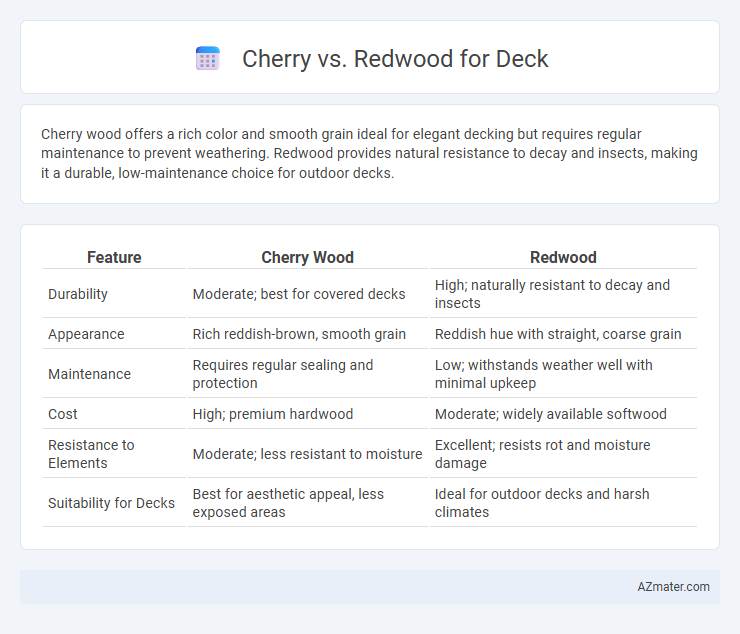Cherry wood offers a rich color and smooth grain ideal for elegant decking but requires regular maintenance to prevent weathering. Redwood provides natural resistance to decay and insects, making it a durable, low-maintenance choice for outdoor decks.
Table of Comparison
| Feature | Cherry Wood | Redwood |
|---|---|---|
| Durability | Moderate; best for covered decks | High; naturally resistant to decay and insects |
| Appearance | Rich reddish-brown, smooth grain | Reddish hue with straight, coarse grain |
| Maintenance | Requires regular sealing and protection | Low; withstands weather well with minimal upkeep |
| Cost | High; premium hardwood | Moderate; widely available softwood |
| Resistance to Elements | Moderate; less resistant to moisture | Excellent; resists rot and moisture damage |
| Suitability for Decks | Best for aesthetic appeal, less exposed areas | Ideal for outdoor decks and harsh climates |
Introduction to Cherry and Redwood as Decking Materials
Cherry wood offers rich reddish hues and fine grain patterns, making it an elegant choice for decking that ages gracefully with exposure to sunlight. Redwood stands out for its natural resistance to decay and insects, combined with a warm coloration and straight grain that enhances outdoor spaces. Both woods provide durable options for decks, with Cherry adding a touch of sophistication and Redwood ensuring longevity in various climates.
Appearance: Color, Grain, and Aesthetics
Cherry wood boasts a rich, warm reddish-brown color that deepens with age, offering a smooth, fine grain that enhances deck aesthetics with a luxurious and elegant appearance. Redwood displays a natural reddish hue with distinct, straight grain patterns and occasional knots, providing a rustic and vibrant look ideal for outdoor decks. Both woods offer unique visual appeal, but Cherry delivers a more refined and polished finish, while Redwood emphasizes natural texture and color variation.
Durability and Lifespan Comparison
Cherry wood offers moderate durability with a lifespan of around 10-15 years in outdoor deck applications, requiring regular maintenance to prevent weathering and rot. Redwood, known for its natural resistance to decay and insect damage, provides superior durability, often lasting 20-30 years or more with proper care. Choosing redwood ensures longer-lasting structural integrity and lower maintenance compared to cherry when used for decking.
Resistance to Rot, Decay, and Insects
Cherry wood offers moderate resistance to rot, decay, and insects but generally requires regular maintenance to prolong its durability when used for decking. Redwood stands out for its natural oils and tannins, providing superior resistance to rot, decay, and insect damage, making it a preferred choice for outdoor decks in humid or insect-prone environments. Choosing redwood can enhance deck longevity and reduce maintenance costs compared to cherry wood.
Maintenance Requirements and Ease of Care
Cherry wood decks require regular sealing and staining every 1-2 years to maintain their rich color and resist moisture damage, while Redwood decks benefit from less frequent maintenance, typically sealing every 3-4 years due to their natural oils and tannins that protect against decay and insects. Both woods need yearly cleaning to prevent dirt build-up and mildew, but Cherry is more prone to scratches and dents, demanding more careful upkeep. Redwood's durability and resistance make it easier to care for overall, especially in varying climates where moisture and UV exposure are concerns.
Environmental Impact and Sustainability
Redwood decking offers a favorable environmental impact due to its natural resistance to decay and pests, reducing the need for chemical treatments. Cherry wood, while prized for its appearance and durability, often requires more intensive harvesting practices that can impact forest ecosystems. Sustainable decking choices favor certified Redwood from responsibly managed forests, ensuring lower carbon footprints and enhanced biodiversity conservation.
Cost Analysis: Upfront and Long-Term
Cherry wood for decks typically demands a higher upfront investment, averaging $12 to $18 per square foot due to its rich color and fine grain, while Redwood costs range from $8 to $15 per square foot, offering a more budget-friendly option. Long-term expenses favor Redwood as it resists decay and insect damage naturally, reducing maintenance and replacement costs compared to Cherry, which requires regular sealing and refinishing to preserve its appearance. Factoring in durability, Redwood's cost-effectiveness over time often outweighs Cherry's initial premium, making it a cost-optimized choice for both budget-conscious and quality-focused homeowners.
Installation Process and Workability
Cherry wood offers a smooth, fine grain that simplifies cutting and sanding during deck installation, making it easier to achieve precise joinery and a polished finish. Redwood is also prized for its workability, featuring a straight grain that reduces splintering and enables efficient nailing and screwing, which speeds up the construction process. Both woods respond well to hand and power tools, but cherry's denser composition requires slightly more effort for shaping compared to the softer, more pliable redwood.
Weather Performance: Sun, Rain, and Temperature Changes
Cherry wood offers moderate weather resistance but requires regular sealing to protect against sun damage and moisture absorption, which can cause warping and discoloration over time. Redwood is naturally rich in tannins and oils, providing superior durability against sun exposure, rain, and fluctuating temperatures, reducing the risk of rot and decay. Its dimensional stability under temperature changes makes redwood a preferred choice for long-lasting, low-maintenance decking in diverse climates.
Pros and Cons Summary: Cherry vs Redwood for Decks
Cherry wood offers a rich, warm hue and smooth grain, making it an aesthetically appealing choice for decks, but it tends to be softer and less weather-resistant than redwood. Redwood is naturally resistant to decay and insects, providing superior durability and longevity for outdoor decking, though it may have a more limited color range and can be more expensive. Homeowners seeking beauty with moderate maintenance might prefer cherry, while those prioritizing durability and environmental resilience often choose redwood for their decks.

Infographic: Cherry vs Redwood for Deck
 azmater.com
azmater.com